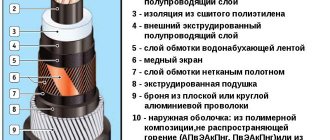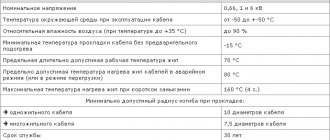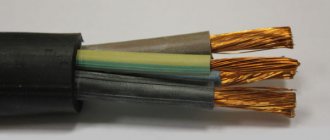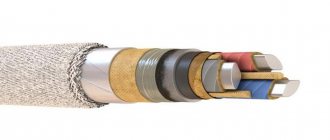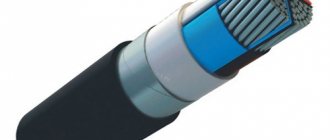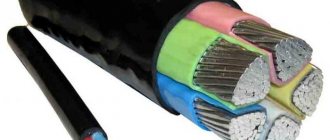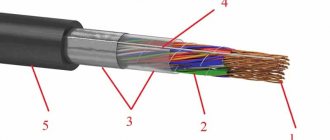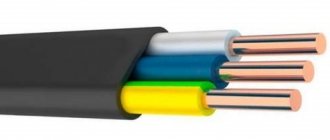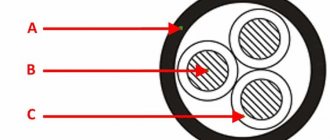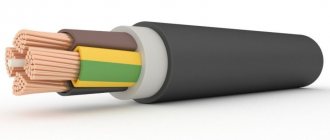Description and design of power cable VVGng-FRLS
Power cable VVGng-FRLS is a cable with copper conductors with insulation and a PVC sheath without protective coverings (armor). The letters “ng-FRLS” are added to the designation of the VVG cable brand if the insulation and sheath of the cable are made of plastic, which is fire-resistant and does not emit harmful substances.
Explanation of the designation:
- absence of the letter “A” at the beginning - copper conductors; — the first “B” — insulation made of PVC plastic, which is fire-resistant and does not emit harmful substances; — the second “B” is a shell made of PVC plastic, which is fire-resistant and does not emit harmful substances; - “G” - lack of armor (naked).
VVGng-FRLS cables can have from one to six cores with a cross-section from 1.5 mm2 to 240 mm2.
The range of core cross-sections depending on their number and operating voltage of the cable is shown in the table.
| Number of cores | Nominal cross-section, mm2 | |
| cable 0.66 kV | 1 kV cable | |
| 1,2,3,4 | 1,5 — 50 | 1,5 — 240 |
| 5,6 | 1,5 — 25 | 1,5 — 25 |
Two-core cables must have cores of the same cross-section. Three-, four- and five-core cables must have all conductors of the same cross-section or one conductor of a smaller cross-section (grounding or neutral conductor). Six-core cables must have four cores of equal cross-section and two wires of smaller cross-section.
The cross-sections of neutral conductors (in the case of a smaller cross-section than the main ones) and grounding conductors, depending on the cross-section of the main conductors up to 50 mm2, are given below.
| Main veins | 1,5 | 2,5 | 4 | 6 | 10 | 16 | 25 | 35 | 50 |
| Zero core | 1,5 | 1,5 | 2,5 | 4 | 6 | 10 | 16 | 16 | 25 |
| Grounding conductor | 1,0 | 1,5 | 2,5 | 2,5 | 4 | 6 | 10 | 16 | 16 |
The nominal and minimum values of insulation thickness for cables with a cross-section of up to 50 mm2 for operating voltages of 0.66 kV and 1 kV are given in the table. The upper limit deviation is not standardized.
| Cable voltage, kV | Nominal cross-section of cores, mm | Nominal insulation thickness, mm | Minimum insulation thickness, mm |
| 0,66 | 1 — 2,5 | 0,6 | 0,44 |
| 4 and 6 | 0,7 | 0,53 | |
| 10 and 16 | 0,9 | 0,71 | |
| 25 and 35 | 1,1 | 0,89 | |
| 50 | 1,3 | 1,07 | |
| 1 | 1-2,5 | 0,8 | 0,62 |
| 4-16 | 1,0 | 0,8 | |
| 25 and 35 | 1,2 | 0,98 | |
| 50 | 1,4 | 1,16 |
The thickness of the sheath of VVG cables depends on the twisting diameter of the insulated cores under the sheath. The nominal and minimum values of the shell thickness are given in the table. The upper limit deviation is not standardized
| Diameter under the shell, mm | Nominal insulation thickness, mm | Minimum insulation thickness, mm |
| Until 6 | 1,2 | 0,92 |
| 6 – 15 | 1,5 | 1,18 |
| 15 – 20 | 1,7 | 1,35 |
| 20 – 30 | 1,9 | 1,52 |
| 30 – 40 | 2,1 | 1,69 |
Entry technique
An astral dream, just like ((as) a lucid one, each person can independently cause
In this case, in turn, it is important to choose the time - wake up in the middle of the night and fall asleep again, and practice leaving the body before going to bed. In this matter, solemnly experiment and select a time that suits you
If you decide to enter the astral plane when going to bed, close your eyes and imagine a measured image before your inner gaze. Consider in detail, in every detail. Spend 2-3 minutes on this, but even if you haven’t seen any pictures, it’s not very profitable, but with practice you will get better.
The next significant moment is an attempt to hear the noises in your head, listen to each overflow and sense a loud increase. Some people can increase the volume by force of their own will, and it is after this that they enter the astral plane. Noises can take the form of a piece of music, which carries the subtle astral mortal shell into other prostrations and worlds.
Try the “separation” practice, linking it to any of your own sensations that exist on the physical level. For example, a popular technique for training a mobile phone is - don’t try to imagine it in your own hand. Just feel how it lies in your hand and, starting from this, try to sit or stand, separating from the physical branch. Remember the sensation, linger on it and repeat until (until) there is complete separation from the body, which you will immediately feel a.
Conditions for installation and operation of the VVGng-FRLS power cable
The VVGng-FRLS cable is manufactured for use at industrial facilities and residential buildings, as well as for use at nuclear power plants (NPS), provided that it is laid outside the containment zone in AC electrical systems of class 2 according to OPB 88/97 classification (PNAE G - 01-011) Cables can be laid in structures with very high fire safety requirements, as well as in explosive zones of all classes, with the exception of class B-1 zones. The materials used in the sheath and insulation of the VVGng-FRLS cable are fire-resistant and do not emit harmful substances. As a result of using cables with the FRLS index, maximum conditions are provided to ensure the safety of people and equipment in the event of a fire.
The cables are designed for group installation and can withstand open fire. The cables are used for use in stationary installations. It is not recommended to use for laying in the ground.
The cables are intended for operation in ambient temperatures from +50°С to -50°С, relative air humidity up to 98% at temperatures up to 35°С.
Can be laid without preheating at a temperature not lower than -15°C. The minimum bending radius during installation must be at least 7.5 times the outer diameter of the cable
Where is it used?
The FRLS cable can replace almost any wires for signaling or communications. Therefore they can be used in the following places
- In showrooms and shopping centers.
- In factories and industrial production where there is an increased fire hazard. These are steel casting plants, chemical, nuclear, metallurgical and many other enterprises.
- At railway stations, bus stations, as well as other public places where there is a need for constant energy supply.
- Medical institutions, health centers, dispensaries.
- Townhouses and private houses.
- Fire or security alarm systems.
- In evacuation control structures, warning, data transmission.
- Mines, high-rise buildings, tunnels, crowded places that can pose a fire hazard.
Scope of application of the frls cable
The FRLS cable allows you to ensure the safety of systems and equipment that are important for saving people, as well as material assets.
Important! Wires are used for installation in cable structures, including hazardous areas.
Technical characteristics of power cable VVGng-FRLS
The conductors must be single-wire or multi-wire. Conductors up to 16 mm2 are made only single-wire, over 16 mm2 can also be multi-wire, i.e. twisted from individual wires (number of wires: at least 7 for sections 16, 25 and 35 mm2; at least 19 for sections 50, 70 and 95 mm2).
The conductors must be insulated and have a distinctive color. The insulation of the neutral conductors should be blue (light blue).
The insulation of the grounding conductors must be two-color (green-yellow).
The color marking must be continuous or in the form of a longitudinal stripe with a width of at least 1 mm. Digital marking of cores is also allowed.
Insulated cable cores must be twisted, the empty space between the twisted insulated cores must be filled with bundles or a mixture of insulating materials.
The sheath must be applied in such a way that it can be easily separated from the core insulation. To do this, a Mylar tape can be laid between the core insulation and the sheath. The shell color is predominantly black.
Cables with sector conductors can be manufactured without filling.
Two-core and three-core cables with cores with a cross-section of up to 16 mm2 inclusive can have insulated cores laid in the same plane - flat cables. In this case, the letter “P” is added to the designation of the VVGng-FRLS cable, separated by a hyphen: example: VVGng-FRLS-P.
It is allowed to twist insulated cable cores for voltages up to 1 kV inclusive, changing the direction of twisting.
Types of conductors
Any cable that is installed indoors has a certain marking. Thanks to it you can find out the technical characteristics of the product. However, a person who is far from electrical work will have difficulty deciphering all kinds of abbreviations. He absolutely does not understand what VVGng means, and what is the difference between these conductors and the classic VVG. First of all, it is necessary to study this issue in detail. Cable types:
- A conventional VVG conductor is equipped with polyvinyl chloride insulation. Thanks to this substance, the cable has fire retardant properties. In addition, such a wire, if damaged by open fire, will extinguish on its own. If the product designation contains the letters ng in addition to VVG, this indicates that the insulating layer contains halogen particles. This element contributes to the fire resistance of the conductor. It does not burn when exposed to fire.
- The explanation of the VVGng ls marking is as follows: the insulating layer is coated with a certain composition, due to which there is no smoke emission during the combustion process. As you know, in most cases it is the wiring that is exposed to fire, creating acrid smoke that spreads throughout the room. Because of this, people lose the ability to navigate in space and often die in a fire. Many cable manufacturers began to use special halogen-free PVC, which significantly reduced gas emissions.
- The VVGng frLS marking is very similar to the previous product, but has improved fire resistance characteristics. The combustion of such a cable in a fire will not spread throughout the entire area of the room. It is made from special halogen-free materials. It has high-quality insulation, so it is often used for wiring in facilities prone to fire.
You might be interested in this Cable channel or profile for LED strip
Requirements for marking power cable VVGng-FRLS
On the sheath no more than every 300 mm the distinctive index of the manufacturer and the year of manufacture of the cable must be applied. For cables with a diameter under the sheath of less than 20 mm, the use of colored marking thread is allowed.
The drum cheek or label attached to the coil or drum must indicate:
— trademark of the manufacturer; — symbol of the cable (full indicating the number of cores and cross-section); — cable length in meters and number of segments; — gross or net weight when delivered in coils in kilograms; — date of manufacture (year, month); — drum or coil number.
The label must bear a technical control stamp and a certification mark.
What are the connection problems?
FRLS cables may release halogens during a fire, which can lead to corrosion. This somewhat narrows the possibility of connecting this product. Thus, during a fire, hydrogen chloride, moving around the room, can combine with water vapor. Condensation occurs and hydrochloric acid deposits on the equipment. Naturally, its quantity is insignificant, but it is enough to limit the use of this cable.
Why do problems occur when connecting the wire?
Weight and dimensions parameters of the power cable VVGng-FRLS
The approximate external dimensions and weights of individual cables with a cross-section of up to 50 mm2 for packaging and transportation purposes are given in the table. The given values may differ for cables of different batches and manufacturers by 10% less or more.
| Section | External size value for packaging and transportation purposes, mm | Weight value for packaging and transportation purposes, kg/km |
| Flat cables | (a x b) | |
| 2x1.5 | 5 x 7.5 | 70 |
| 2x2.5 | 5.5 x 8 | 90 |
| 2x4 | 6 x 9.5 | 140 |
| 2×6 | 7 x 10.5 | 180 |
| 3x1.5 | 5 x 9.5 | 95 |
| 3x1.5 | 5.5 x 11 | 135 |
| 3x4 | 6 x 13 | 200 |
| Stranded cables | Diameter | |
| 3x1.5 | 8 | 90 |
| 3x2.5 | 9,5 | 135 |
| 3x4 | 11 | 200 |
| 3x6 | 12 | 260 |
| 3x10 | 14,5 | 410 |
| 3x16 | 17 | 590 |
| 3x25 | 20,5 | 810 |
| 3x35 | 23 | 1300 |
| 3x50 | 27 | 1700 |
| 3x4+1x2.5 | 12 | 230 |
| 3x6+1x4 | 14 | 310 |
| 3x10+1x6 | 16 | 480 |
| 3x16+1x10 | 19 | 650 |
| 4x1.5 | 8,5 | 110 |
| 4x2.5 | 10 | 170 |
| 4x4 | 12 | 240 |
| 4x6 | 13 | 320 |
| 4x10 | 16 | 510 |
| 4x16 | 19 | 750 |
| 4x25 | 23 | 1150 |
| 4x35 | 26 | 1550 |
| 4x50 | 31 | 2200 |
| 5x1.5 | 9,5 | 135 |
| 5x2.5 | 11 | 205 |
| 5x4 | 13 | 300 |
| 5x6 | 14 | 405 |
| 5x10 | 17,5 | 630 |
| 5x16 | 21 | 950 |
| 5x25 | 26 | 1450 |
| 5x35 | 29 | 1900 |
| 5x50 | 35 | 2700 |
Areas of application
The VVGng (A) FRLS cable is distinguished by positive performance characteristics that have made it indispensable in many modern areas. The introduction of the latest technologies for the development of electrical wires has made it possible to expand the existing list of industries where FRLS is now actively used. The presence of professional labeling has greatly simplified the selection of the necessary products.
Installers and electricians actively use this type of cable to implement the following ideas:
- High-quality installation of wiring in the ground. For such work, special protective measures are needed to prevent negative mechanical effects. The installation process itself involves hiding the cable in a metal tube or box.
- FRLS wire is actively used in areas where it is necessary to eliminate the possibility of fire. During open installation, the master must choose those places where exclusively non-combustible materials were used. If the wiring is suspended, then you need to prevent it from sagging.
- In many homes and industrial facilities, such a cable is used for laying in the walls of a building.
Wiring can only be stored indoors or under a canopy. Manufacturers allow the cable to be kept on drums in a place unprotected from atmospheric precipitation. Such products can be stored indoors for 10 years, under a canopy for 5 years, and in an open area for a maximum of 24 months.
Load currents of power cable VVGng-FRLS
Permissible load currents for cables with a cross-section of up to 50 mm2 laid in air are indicated in the table.
| Number of cores | Permissible load current, A | ||
| With two cores | With three cores | With four | |
| 1,5 | 24 | 21 | 19 |
| 2,5 | 33 | 28 | 26 |
| 4 | 44 | 37 | 34 |
| 6 | 56 | 49 | 45 |
| 10 | 76 | 66 | 61 |
| 16 | 101 | 87 | 81 |
| 25 | 134 | 115 | 107 |
| 35 | 166 | 141 | 131 |
| 50 | 208 | 177 | 165 |
Decryption rules
Many novice craftsmen often come across a cable marked LS and FRLS, but they do not know what it means. But it’s simple - both of these abbreviations indicate the same performance indicator - a low percentage of smoke emission. Having decided to decrypt the FRLS cable yourself, you need to remember the following parameters:
- LS (Low Smoke) - no smoke.
- FR (Fire Resistance) - high-quality fire protection.
The essence of these two markings is the same, and all other characteristics will correspond to the selected cable type.
It is worth noting that Russian and foreign letters are often combined. That is why there are simply no special differences between FRLS and AVVGng. The wires may contain round, flat and even triangular conductors. The advantage is that there are virtually no halogens in the cable smoke, which makes the product more resistant to fire.
The interpretation of VVGng (A) - FRLS cable implies the fact that such a product can be safely used to transmit electricity at a frequency of 50 Hz with a rated voltage of 0.66 kilovolts. In more powerful stationary installations this figure can reach 6 kilovolts.
Available methods for quality control of power cable VVGng-FRLS
Control methods are presented that, while not strictly complying with GOST, allow preliminary conclusions to be drawn about the quality of the cable if the measured values differ significantly from the regulated ones. The final conclusion about the cable's compliance with GOST can be made only after testing the cable in a specialized laboratory using strict methods and in the volumes specified in the standard.
Visual inspection. The following can be checked: the number and color of the cores, the number of wires in the core, the integrity of the insulation and sheath and the ease (without damage) of their separation.
Measuring structural dimensions. Can be checked using suitable measuring instruments: insulation and sheath thickness. Measuring the diameter of the wires dpr and calculating the cross-section of the core using the formula 0.785dpr2N (where N is the number of wires in the core) is not a strict method for controlling the cross-section of the cores, because confirmation of cross-section compliance is electrical resistance, however, a significant deviation of the calculated cross-section from the nominal (more than 10%) may serve as a basis for doubts about the quality.
Measuring the electrical resistance of current-carrying conductors. It can be carried out on a finished cable with an ohmmeter with a suitable measurement limit (for cables with a small cross-section at a normal length in a coil or on a drum it can be several Ohms) and recalculated to a length of 1 km. If the cable has twisted cores, the obtained values should be reduced by 1.02 times. Particular attention should be paid to making good contact with the test leads.
Winding test after exposure at low temperature. If you have a large freezer compartment of a household refrigerator with temperatures down to -15°C, you can check the quality of the cable sheath with an outer diameter of up to 20 mm. To do this, a piece of cable approximately 1.2 m long, rolled for compactness into a ring with a diameter of at least 40 cm, is placed in the freezer for 45 minutes, after which it is removed from the chamber and, in no more than 5 minutes, is wound onto the cylinder (drum) in a full turn first in one direction, then in the opposite direction. The material of the cylinder (drum) can be any - wood, plastic, metal. The diameter of the cylinder (drum) should be 15(Dн + d) ±5%, where Dн is the outer diameter of the cable in mm (for flat sheath thickness), d is the diameter of any of the main insulated cores in mm. A high-quality shell should not have cracks or tears.
Design differences
The FRLS multifunctional cable is a kind of twisting of cores that are reliably isolated from each other. This material is made from high quality copper. Each core is placed in an outer sheath made of polyvinyl chloride for additional protection. The design provides for the presence of several powerful wires, which differ in cross-sectional area - from 1.5 to 10 square meters. mm. The main advantages of such a cable include the presence of a universal thermal barrier made of mica-containing material. This element performs the function of a dielectric.
An insulating layer of polyvinyl chloride is mounted on top of the thermal barrier. This design is characterized by a reduced level of flammability and the absence of smoke during combustion. The next ball is represented by modern waist insulation, which is made from durable PVC-based materials. At the final stage, an outer sheath is necessarily applied to the wire, which is presented in the form of fire-resistant plastic.
If there is an additional FRHF marking, then in addition to the usual fire resistance, the final halogen content in the smoke will be much lower than that of all other analogues. Thanks to this, you can reduce the negative impact on the environment in case of an unforeseen situation.
Product advantages
Fire safety
. The cable does not burn either in a bundle or individually. It does not support combustion, does not spread fire, and retains its operating functions in case of fire for three hours.
Low smoke emission
. The material from which the external and internal insulation is made emits very little smoke when burned.
Reliability
. FRLS maintains its performance characteristics at significant temperature increases. It is designed for stable operation in a fire for three hours, thanks to which security and fire alarms continue to function in extreme conditions.
Moisture resistance
. Multi-layer insulation provides a high level of protection against water. The cable can be laid in wet areas, for example, with a swimming pool, bathroom, etc.
Mechanical strength
. The PVC plastic compound from which the insulation is made can withstand significant compression and bending loads without deforming or losing integrity. This allows the FRLS to be used in complex circuits that require twisting and bending.
Easy to use
. In a stranded wire, each core has its own color of the insulating layer, for example, the grounding is always yellow-green. This color designation greatly facilitates the use of the cable and simplifies its installation.

